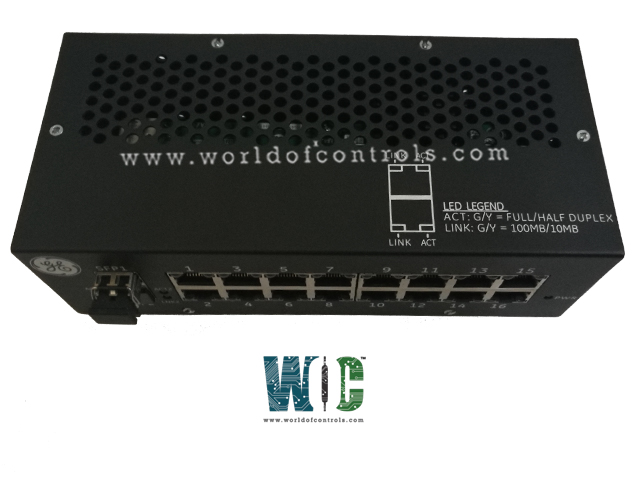
World Of Controls understands the criticality of your requirement and works towards reducing the lead time as much as possible.
IS420ESWBH1A, REV C - 16 ports Ethernet IONet Switch 10/100Base-TX is available in stock which ships the same day.
IS420ESWBH1A, REV C - 16 ports Ethernet IONet Switch 10/100Base-TX comes in UNUSED as well as REBUILT condition.
To avail our best deals for IS420ESWBH1A, REV C - 16 ports Ethernet IONet Switch 10/100Base-TX, contact us and we will get back to you within 24 hours.
SPECIFICATIONS:
Part Number: IS420ESWBH1A, REV C
Manufacturer: General Electric
Series: Mark VIe
Function: IONet Switch 10/100Base-TX
Dimensions: 162 mm X 115 mm X 72 mm
Operating Temperature: -40°C to +70°C
Controller and I/O module Redundancy: Simplex
Internal operating system: QNX
Operating Voltage: 9 V to 16 V DC
Analog outputs: 0 to 10 V
Configuration Software: ToolboxST
Ethernet Ports: 2 Ethernet ports
Memory: 256 MB onboard flash
Country of Manufacture: United States (USA)
Availability: In Stock
Manual: GEH-6721
FUNCTIONAL DESCRIPTION:
IS420ESWBH1A, REV C is a 16-Port Ethernet IONet Switch 10/100Base-TX manufactured and designed by General Electric as part of the Mark VIe Series used in GE Distributed Control Systems. ESWBs are specifically designed to meet the needs of real-time industrial control solutions and are required for all IONet switches used in a Mark* VIe and Mark VIeS Safety control system. Each hardware form is available in five versions (H1A through H5A)that vary in fiber-optic port configuration options, which include no fiber ports, multi-mode fiber ports, or single-mode (longer distance) fiber ports. Refer to the IS420ESWAH#A IONet Switch Specifications table and the IS420ESWBH#A IONet Switch Specifications table for these fiber option details. The device supports robust Ethernet communication and networking capabilities, offering the following key features:
DISTRIBUTED I/O MODULES:
The I/O modules contain three basic parts: the terminal board, the terminal block, and the I/O pack. The terminal board mounts to the cabinet and comes in two basic types: S and T. The I/O pack mounts to the terminal board J-port connector. Both terminal board types provide the following features:
I/O PACKS:
I/O packs have a common processor board and a data acquisition board that is unique to the type of connected device. I/O packs on each terminal board digitize the I/O variables, perform algorithms, and communicate with the controller. The I/O pack provides fault detection through a combination of special circuitry in the data acquisition board and software running in the Central Processing Unit (CPU)board. The fault status is transmitted to and used by the controllers. The I/O pack transmits inputs and receives outputs on both network interfaces if connected. Each I/O pack also sends an identification message (ID packet) to the main controller when requested. The packet contains the hardware catalog number of the I/O board, the hardware revision, the board barcode serial number, the firmware catalog number, and the firmware version. The I/O packs have a temperature sensor that is accurate to within ±2°C (±3.6 °F). Every I/O pack temperature is available in the database and can be used to generate an alarm.
TERMINAL BOARDS:
Signal flow begins with a sensor connected to a terminal block on a board. Wide and narrow terminal boards are arranged in vertical columns of high and low-level wiring. An example of a wide board is a board that contains magnetic relays with fused circuits for solenoid drivers. A shield strip is provided to the left of each terminal block. It can be connected to a metal base for immediate grounding or floated to allow individual ground wires from each board to be wired to a centralized, cabinet ground strip.
The ESWx switches can be DIN-rail mounted using one of three GE-qualified DIN-rail mounting clips, depending on the hardware form (ESWA or ESWB) and the selected DIN-rail mounting orientation. The clips are ordered separately, according to the following table. Mounting screws are included with each switch.
WOC has the largest stock of GE Distributed Control System Replacement Parts. We can also supply unused and rebuilt backup with a warranty. Our team of experts is available around the clock to support your OEM needs. Our team of experts at WOC is happy to assist you with any of your automation requirements. For pricing and availability on any parts and repairs, kindly get in touch with our team by phone or email.
What type of Ethernet ports are provided on the switch?
The switch is equipped with 16 copper Ethernet ports that support 10/100Base-TX, allowing both 10 Mbps and 100 Mbps data transmission speeds. These ports use RJ45 connectors and support auto-negotiation for speed and duplex modes, making the switch suitable for connecting a range of industrial Ethernet devices.
Does the switch support auto-negotiation and auto-MDIX?
Yes, the switch features both auto-negotiation and HP Auto-MDIX functionality. Auto-negotiation allows the switch to automatically adjust the speed and duplex mode of each port based on the connected device. Auto-MDIX eliminates the need for crossover cables by automatically configuring the port to match the type of Ethernet cable being used.
What is the speed and duplex capability of the switch's Ethernet ports?
Each of the 16 copper Ethernet ports on the switch supports both 10 Mbps and 100 Mbps speeds. These ports are equipped with auto-negotiation capabilities, allowing them to automatically select the best operational speed and duplex setting—either half-duplex or full-duplex—depending on the connected device. This adaptive behavior improves overall network performance and communication stability.